University Economics Assignment: Principles of Economics, Semester 1
VerifiedAdded on 2023/01/16
|11
|1483
|41
Homework Assignment
AI Summary
This assignment delves into core principles of economics, addressing key macroeconomic concepts through a series of short-answer questions. It begins by examining a Keynesian cross diagram, identifying a recessionary gap and exploring Keynesian solutions like expansionary fiscal policy. The assig...
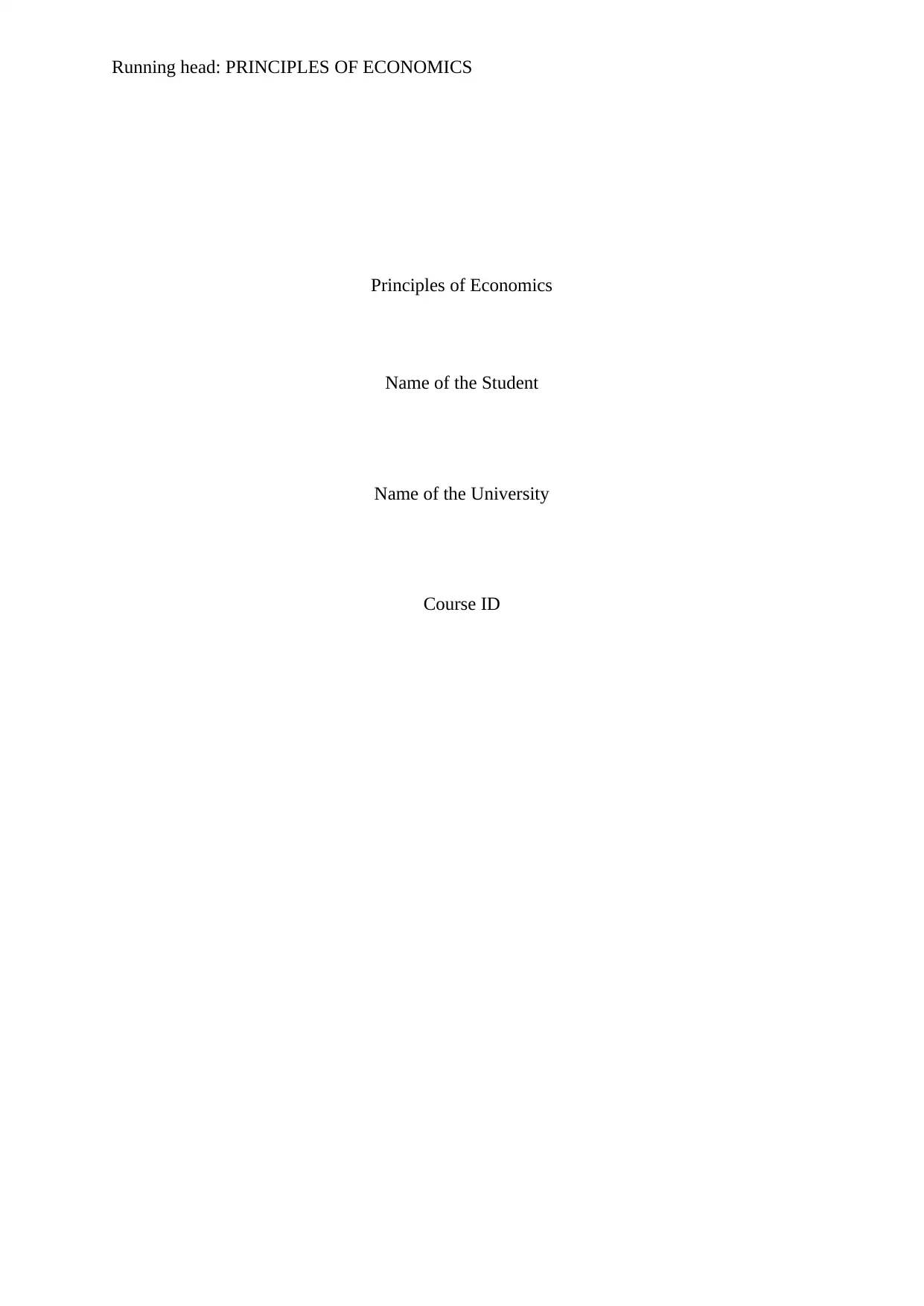
Running head: PRINCIPLES OF ECONOMICS
Principles of Economics
Name of the Student
Name of the University
Course ID
Principles of Economics
Name of the Student
Name of the University
Course ID
Paraphrase This Document
Need a fresh take? Get an instant paraphrase of this document with our AI Paraphraser
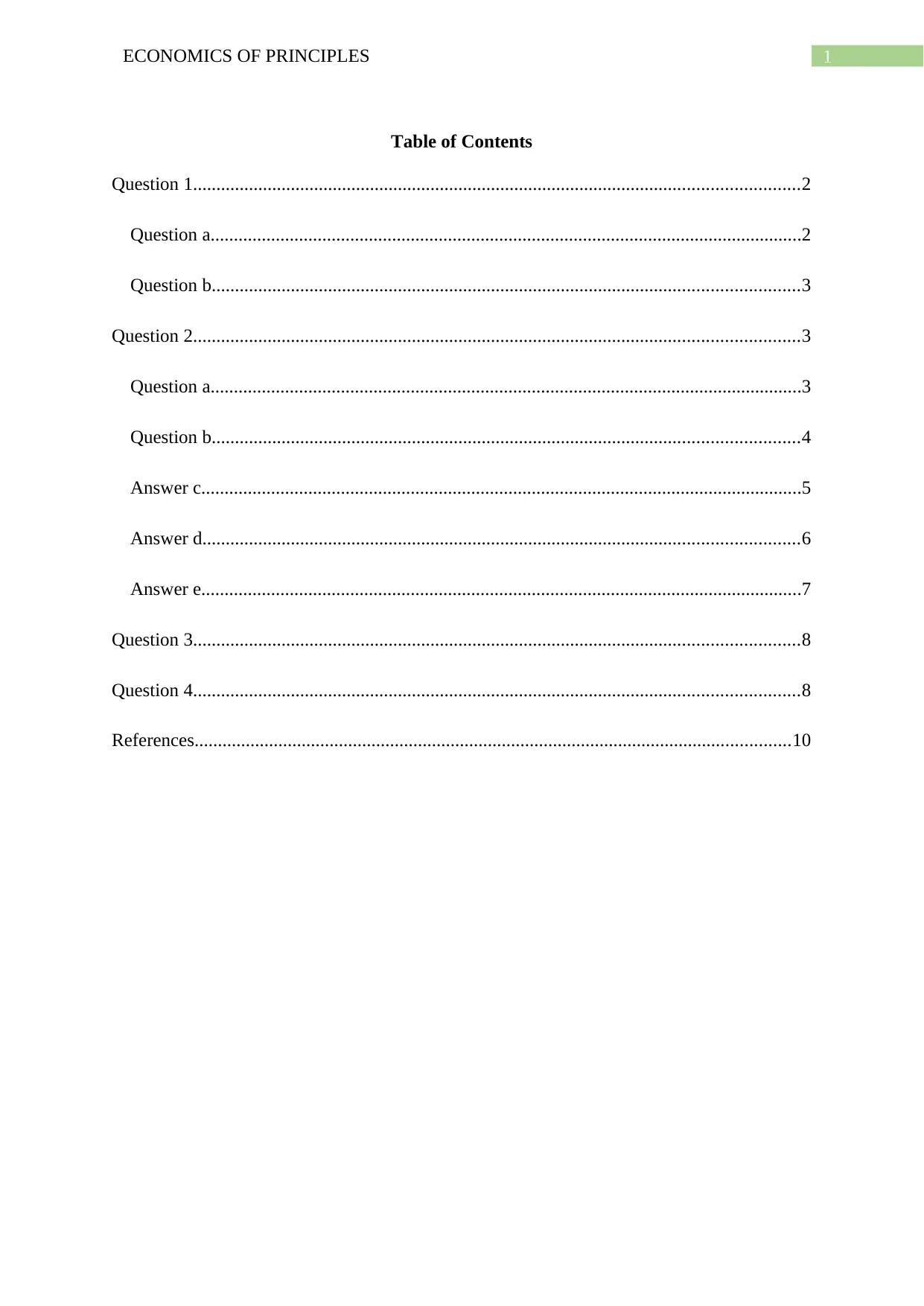
1ECONOMICS OF PRINCIPLES
Table of Contents
Question 1..................................................................................................................................2
Question a...............................................................................................................................2
Question b..............................................................................................................................3
Question 2..................................................................................................................................3
Question a...............................................................................................................................3
Question b..............................................................................................................................4
Answer c.................................................................................................................................5
Answer d................................................................................................................................6
Answer e.................................................................................................................................7
Question 3..................................................................................................................................8
Question 4..................................................................................................................................8
References................................................................................................................................10
Table of Contents
Question 1..................................................................................................................................2
Question a...............................................................................................................................2
Question b..............................................................................................................................3
Question 2..................................................................................................................................3
Question a...............................................................................................................................3
Question b..............................................................................................................................4
Answer c.................................................................................................................................5
Answer d................................................................................................................................6
Answer e.................................................................................................................................7
Question 3..................................................................................................................................8
Question 4..................................................................................................................................8
References................................................................................................................................10
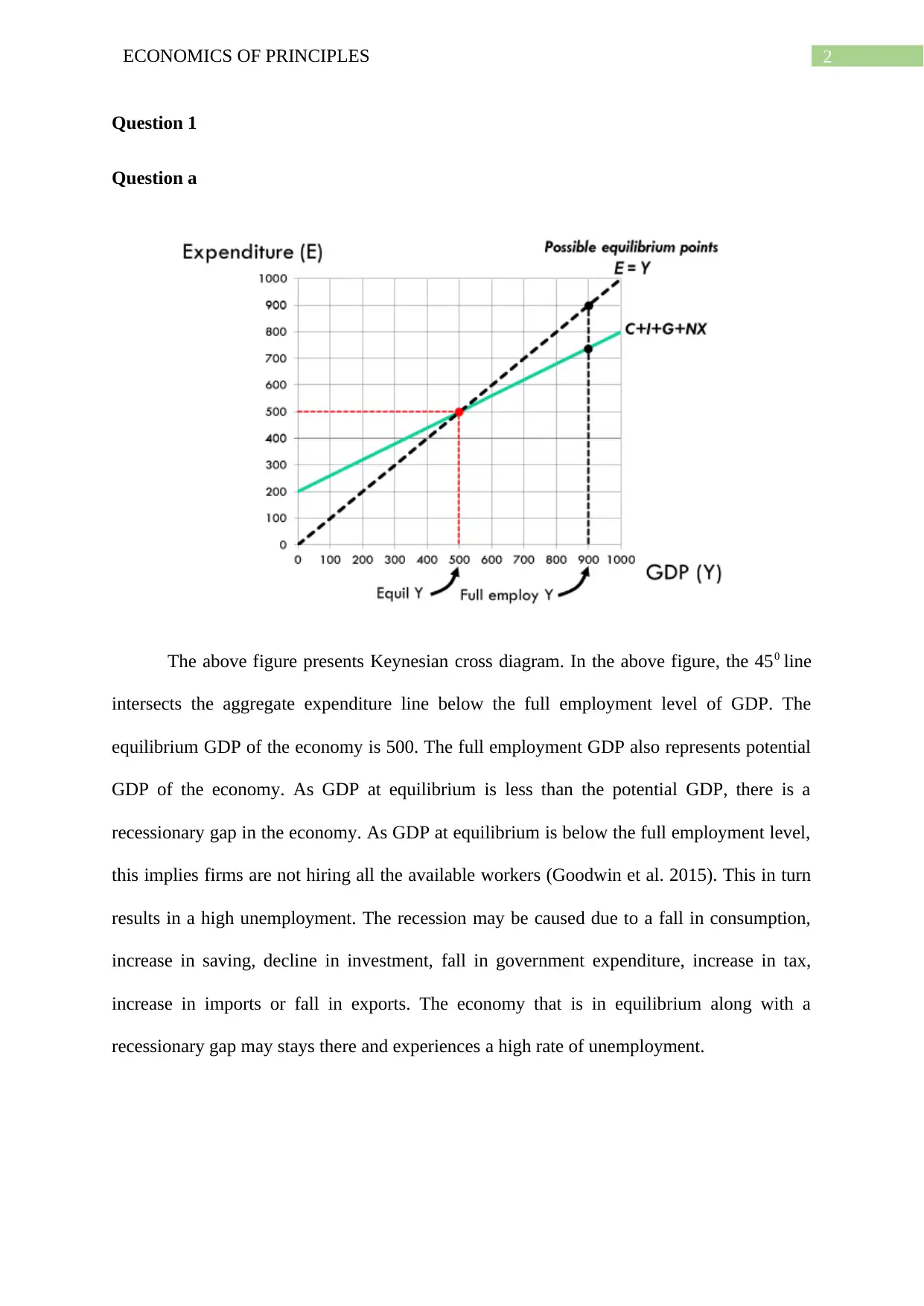
2ECONOMICS OF PRINCIPLES
Question 1
Question a
The above figure presents Keynesian cross diagram. In the above figure, the 450 line
intersects the aggregate expenditure line below the full employment level of GDP. The
equilibrium GDP of the economy is 500. The full employment GDP also represents potential
GDP of the economy. As GDP at equilibrium is less than the potential GDP, there is a
recessionary gap in the economy. As GDP at equilibrium is below the full employment level,
this implies firms are not hiring all the available workers (Goodwin et al. 2015). This in turn
results in a high unemployment. The recession may be caused due to a fall in consumption,
increase in saving, decline in investment, fall in government expenditure, increase in tax,
increase in imports or fall in exports. The economy that is in equilibrium along with a
recessionary gap may stays there and experiences a high rate of unemployment.
Question 1
Question a
The above figure presents Keynesian cross diagram. In the above figure, the 450 line
intersects the aggregate expenditure line below the full employment level of GDP. The
equilibrium GDP of the economy is 500. The full employment GDP also represents potential
GDP of the economy. As GDP at equilibrium is less than the potential GDP, there is a
recessionary gap in the economy. As GDP at equilibrium is below the full employment level,
this implies firms are not hiring all the available workers (Goodwin et al. 2015). This in turn
results in a high unemployment. The recession may be caused due to a fall in consumption,
increase in saving, decline in investment, fall in government expenditure, increase in tax,
increase in imports or fall in exports. The economy that is in equilibrium along with a
recessionary gap may stays there and experiences a high rate of unemployment.
⊘ This is a preview!⊘
Do you want full access?
Subscribe today to unlock all pages.

Trusted by 1+ million students worldwide

3ECONOMICS OF PRINCIPLES
Question b
Keynesian solution to a recessionary gap is to adapt an expansionary fiscal policy.
Keynes suggested that an expansionary fiscal policy can be taken in the form of direct cut in
tax rates which helps to increase consumption and investment shifting the aggregate demand
curve outward. Government could make additional expenditure on roads, housing or other
public goods (Uribe and Schmitt-Grohe 2017). Any form of additional government spending
or cut in taxes increases aggregate expenditure shifting the curve to the right. In response to
such a policy, the economy reaches to a new equilibrium where actual GDP equals the
potential GDP.
Question 2
Question a
The increase in official cash rate is a part of contractionary monetary policy. An
increase in official cash rate increases other interest rate in the economy. Interest rate is the
cost of investment. An increase in interest rate thus lowers the level of investment.
Investment is one important components of aggregate demand. A decline in investment
causes a decline in aggregate demand. The aggregate demand curve shifts to the left (Heijdra
2017). Given the aggregate supply, a decline in aggregate demand shifts short run
equilibrium to the left. As a result, equilibrium price falls from P* to P1 and that of
equilibrium GDP declines to Y1.
Question b
Keynesian solution to a recessionary gap is to adapt an expansionary fiscal policy.
Keynes suggested that an expansionary fiscal policy can be taken in the form of direct cut in
tax rates which helps to increase consumption and investment shifting the aggregate demand
curve outward. Government could make additional expenditure on roads, housing or other
public goods (Uribe and Schmitt-Grohe 2017). Any form of additional government spending
or cut in taxes increases aggregate expenditure shifting the curve to the right. In response to
such a policy, the economy reaches to a new equilibrium where actual GDP equals the
potential GDP.
Question 2
Question a
The increase in official cash rate is a part of contractionary monetary policy. An
increase in official cash rate increases other interest rate in the economy. Interest rate is the
cost of investment. An increase in interest rate thus lowers the level of investment.
Investment is one important components of aggregate demand. A decline in investment
causes a decline in aggregate demand. The aggregate demand curve shifts to the left (Heijdra
2017). Given the aggregate supply, a decline in aggregate demand shifts short run
equilibrium to the left. As a result, equilibrium price falls from P* to P1 and that of
equilibrium GDP declines to Y1.
Paraphrase This Document
Need a fresh take? Get an instant paraphrase of this document with our AI Paraphraser
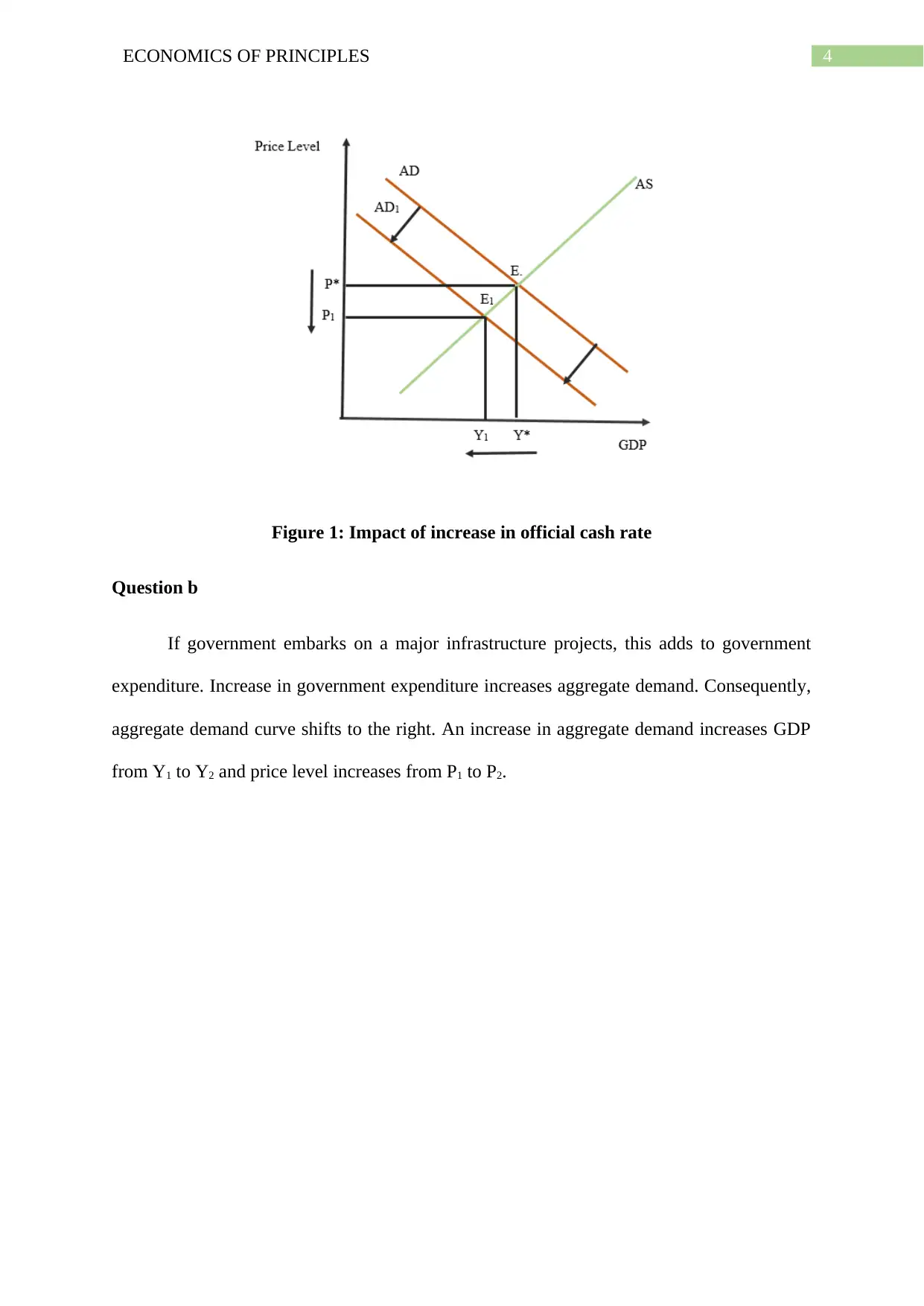
4ECONOMICS OF PRINCIPLES
Figure 1: Impact of increase in official cash rate
Question b
If government embarks on a major infrastructure projects, this adds to government
expenditure. Increase in government expenditure increases aggregate demand. Consequently,
aggregate demand curve shifts to the right. An increase in aggregate demand increases GDP
from Y1 to Y2 and price level increases from P1 to P2.
Figure 1: Impact of increase in official cash rate
Question b
If government embarks on a major infrastructure projects, this adds to government
expenditure. Increase in government expenditure increases aggregate demand. Consequently,
aggregate demand curve shifts to the right. An increase in aggregate demand increases GDP
from Y1 to Y2 and price level increases from P1 to P2.
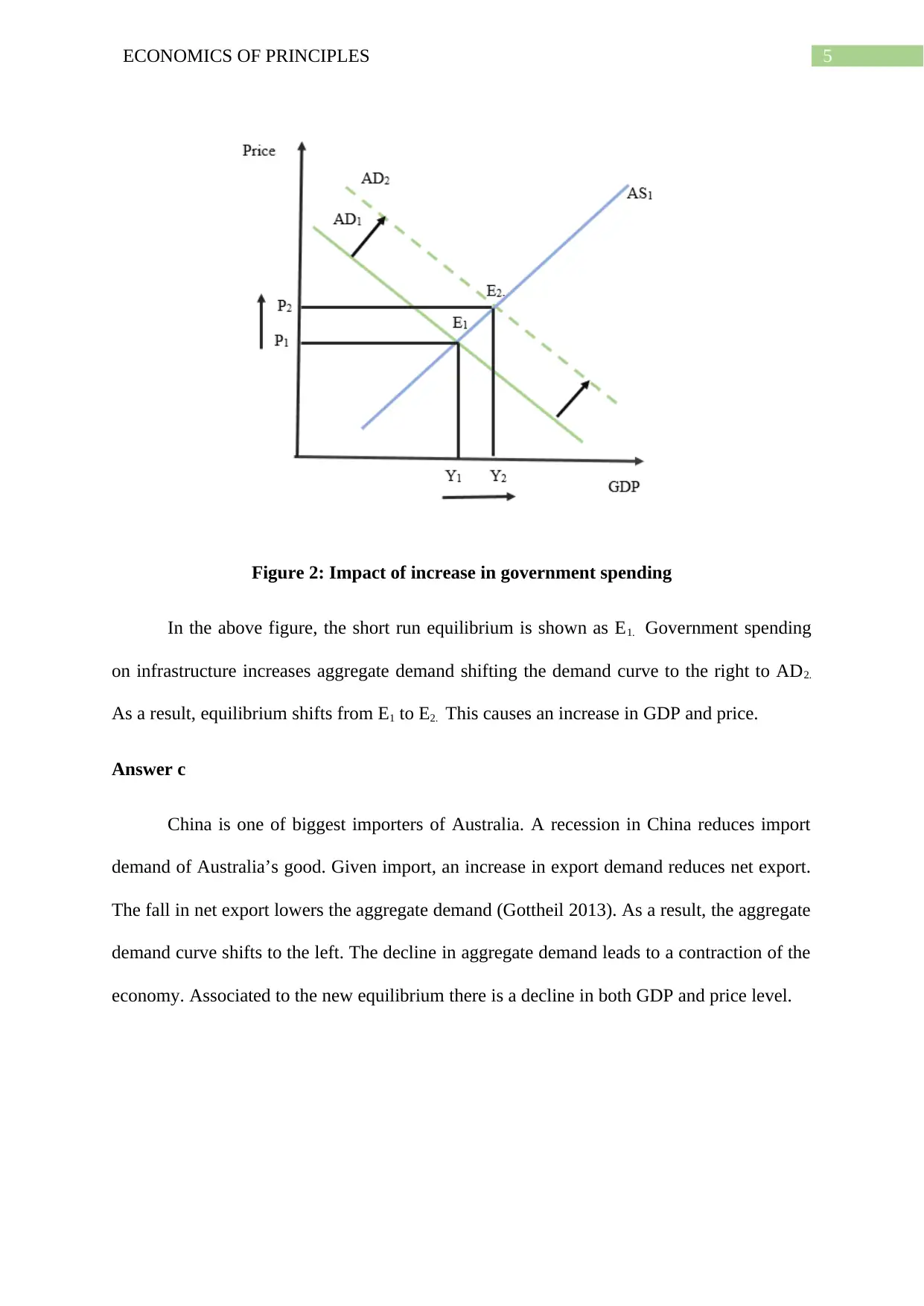
5ECONOMICS OF PRINCIPLES
Figure 2: Impact of increase in government spending
In the above figure, the short run equilibrium is shown as E1. Government spending
on infrastructure increases aggregate demand shifting the demand curve to the right to AD2.
As a result, equilibrium shifts from E1 to E2. This causes an increase in GDP and price.
Answer c
China is one of biggest importers of Australia. A recession in China reduces import
demand of Australia’s good. Given import, an increase in export demand reduces net export.
The fall in net export lowers the aggregate demand (Gottheil 2013). As a result, the aggregate
demand curve shifts to the left. The decline in aggregate demand leads to a contraction of the
economy. Associated to the new equilibrium there is a decline in both GDP and price level.
Figure 2: Impact of increase in government spending
In the above figure, the short run equilibrium is shown as E1. Government spending
on infrastructure increases aggregate demand shifting the demand curve to the right to AD2.
As a result, equilibrium shifts from E1 to E2. This causes an increase in GDP and price.
Answer c
China is one of biggest importers of Australia. A recession in China reduces import
demand of Australia’s good. Given import, an increase in export demand reduces net export.
The fall in net export lowers the aggregate demand (Gottheil 2013). As a result, the aggregate
demand curve shifts to the left. The decline in aggregate demand leads to a contraction of the
economy. Associated to the new equilibrium there is a decline in both GDP and price level.
⊘ This is a preview!⊘
Do you want full access?
Subscribe today to unlock all pages.

Trusted by 1+ million students worldwide
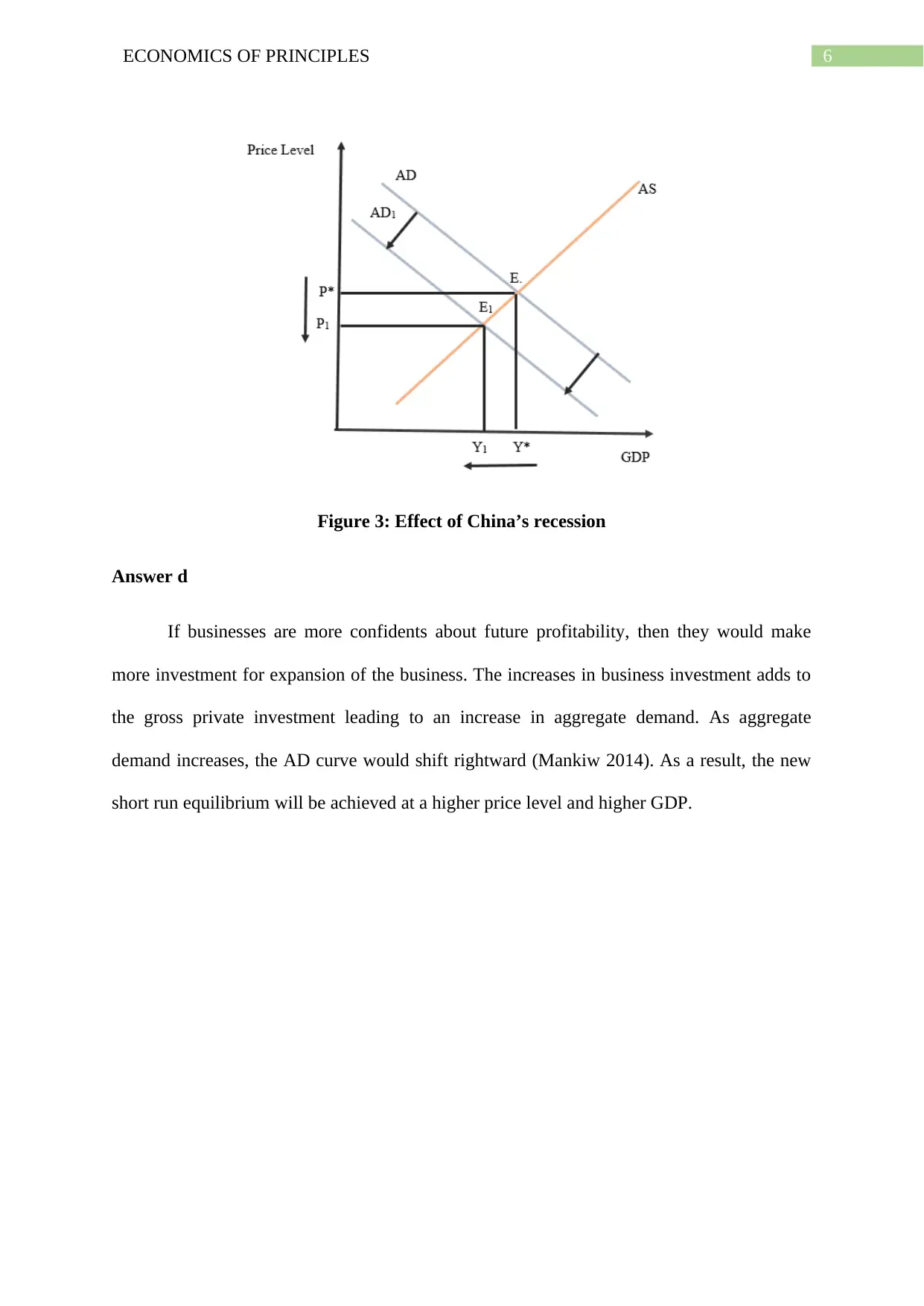
6ECONOMICS OF PRINCIPLES
Figure 3: Effect of China’s recession
Answer d
If businesses are more confidents about future profitability, then they would make
more investment for expansion of the business. The increases in business investment adds to
the gross private investment leading to an increase in aggregate demand. As aggregate
demand increases, the AD curve would shift rightward (Mankiw 2014). As a result, the new
short run equilibrium will be achieved at a higher price level and higher GDP.
Figure 3: Effect of China’s recession
Answer d
If businesses are more confidents about future profitability, then they would make
more investment for expansion of the business. The increases in business investment adds to
the gross private investment leading to an increase in aggregate demand. As aggregate
demand increases, the AD curve would shift rightward (Mankiw 2014). As a result, the new
short run equilibrium will be achieved at a higher price level and higher GDP.
Paraphrase This Document
Need a fresh take? Get an instant paraphrase of this document with our AI Paraphraser
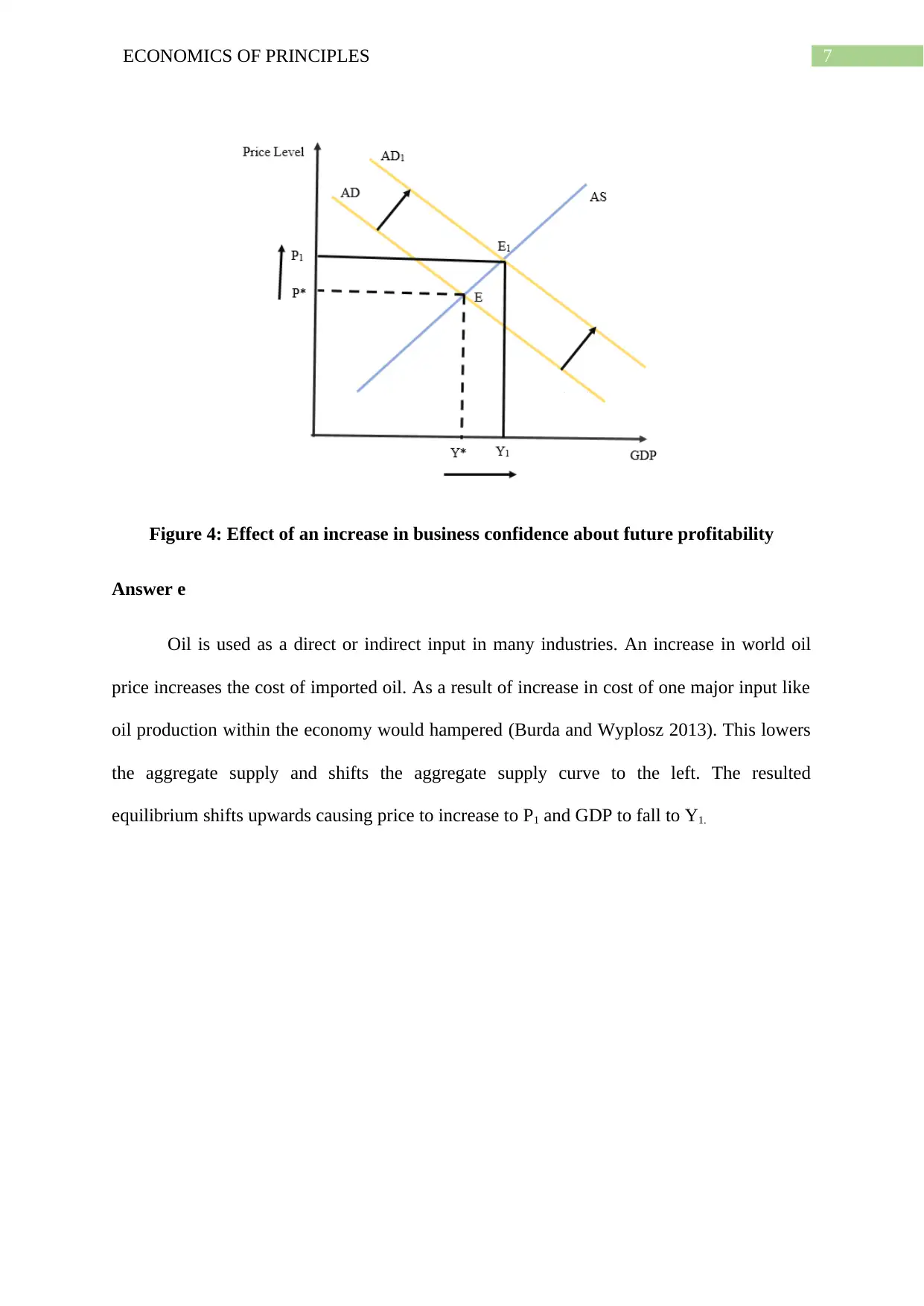
7ECONOMICS OF PRINCIPLES
Figure 4: Effect of an increase in business confidence about future profitability
Answer e
Oil is used as a direct or indirect input in many industries. An increase in world oil
price increases the cost of imported oil. As a result of increase in cost of one major input like
oil production within the economy would hampered (Burda and Wyplosz 2013). This lowers
the aggregate supply and shifts the aggregate supply curve to the left. The resulted
equilibrium shifts upwards causing price to increase to P1 and GDP to fall to Y1.
Figure 4: Effect of an increase in business confidence about future profitability
Answer e
Oil is used as a direct or indirect input in many industries. An increase in world oil
price increases the cost of imported oil. As a result of increase in cost of one major input like
oil production within the economy would hampered (Burda and Wyplosz 2013). This lowers
the aggregate supply and shifts the aggregate supply curve to the left. The resulted
equilibrium shifts upwards causing price to increase to P1 and GDP to fall to Y1.
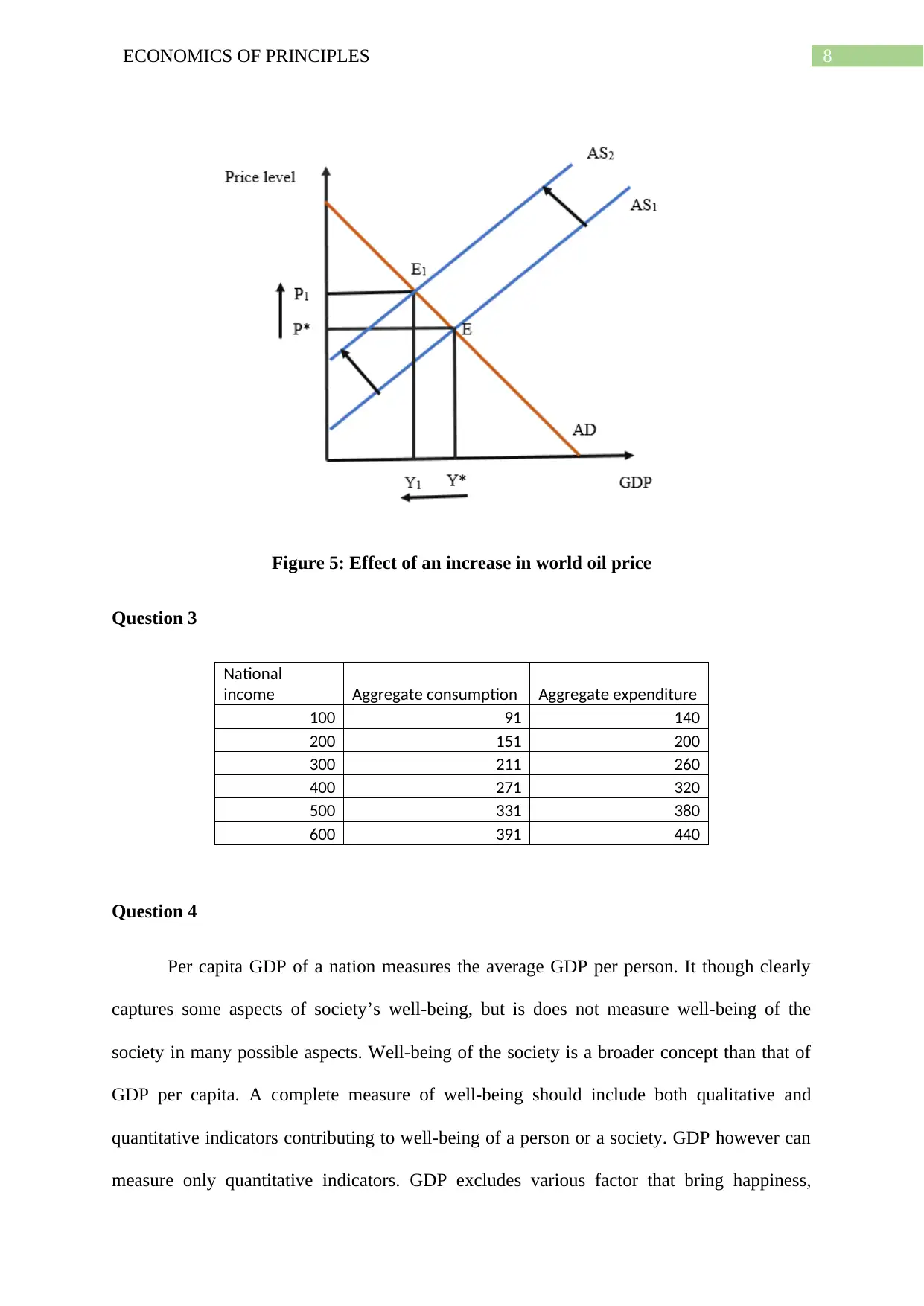
8ECONOMICS OF PRINCIPLES
Figure 5: Effect of an increase in world oil price
Question 3
National
income Aggregate consumption Aggregate expenditure
100 91 140
200 151 200
300 211 260
400 271 320
500 331 380
600 391 440
Question 4
Per capita GDP of a nation measures the average GDP per person. It though clearly
captures some aspects of society’s well-being, but is does not measure well-being of the
society in many possible aspects. Well-being of the society is a broader concept than that of
GDP per capita. A complete measure of well-being should include both qualitative and
quantitative indicators contributing to well-being of a person or a society. GDP however can
measure only quantitative indicators. GDP excludes various factor that bring happiness,
Figure 5: Effect of an increase in world oil price
Question 3
National
income Aggregate consumption Aggregate expenditure
100 91 140
200 151 200
300 211 260
400 271 320
500 331 380
600 391 440
Question 4
Per capita GDP of a nation measures the average GDP per person. It though clearly
captures some aspects of society’s well-being, but is does not measure well-being of the
society in many possible aspects. Well-being of the society is a broader concept than that of
GDP per capita. A complete measure of well-being should include both qualitative and
quantitative indicators contributing to well-being of a person or a society. GDP however can
measure only quantitative indicators. GDP excludes various factor that bring happiness,
⊘ This is a preview!⊘
Do you want full access?
Subscribe today to unlock all pages.

Trusted by 1+ million students worldwide
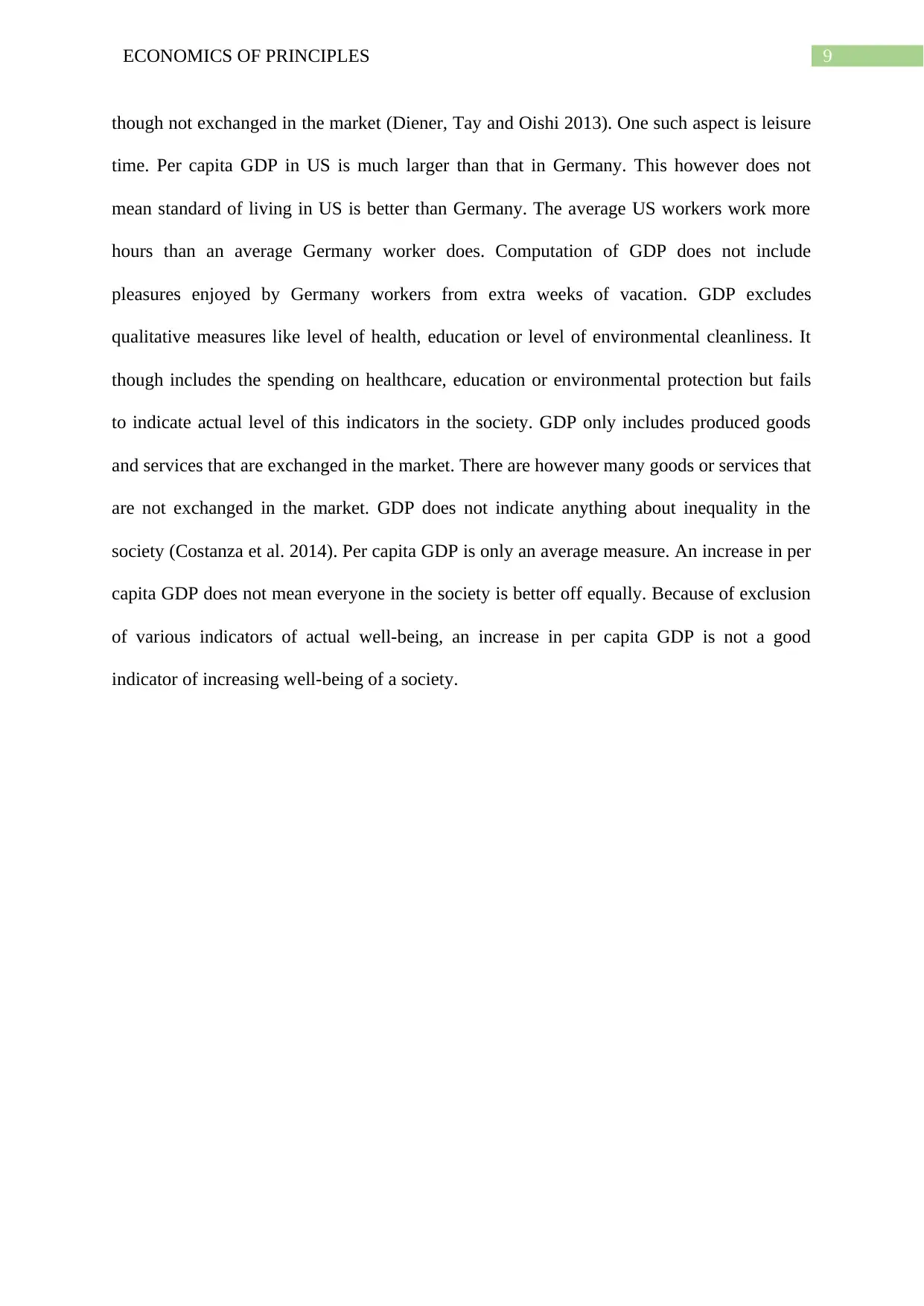
9ECONOMICS OF PRINCIPLES
though not exchanged in the market (Diener, Tay and Oishi 2013). One such aspect is leisure
time. Per capita GDP in US is much larger than that in Germany. This however does not
mean standard of living in US is better than Germany. The average US workers work more
hours than an average Germany worker does. Computation of GDP does not include
pleasures enjoyed by Germany workers from extra weeks of vacation. GDP excludes
qualitative measures like level of health, education or level of environmental cleanliness. It
though includes the spending on healthcare, education or environmental protection but fails
to indicate actual level of this indicators in the society. GDP only includes produced goods
and services that are exchanged in the market. There are however many goods or services that
are not exchanged in the market. GDP does not indicate anything about inequality in the
society (Costanza et al. 2014). Per capita GDP is only an average measure. An increase in per
capita GDP does not mean everyone in the society is better off equally. Because of exclusion
of various indicators of actual well-being, an increase in per capita GDP is not a good
indicator of increasing well-being of a society.
though not exchanged in the market (Diener, Tay and Oishi 2013). One such aspect is leisure
time. Per capita GDP in US is much larger than that in Germany. This however does not
mean standard of living in US is better than Germany. The average US workers work more
hours than an average Germany worker does. Computation of GDP does not include
pleasures enjoyed by Germany workers from extra weeks of vacation. GDP excludes
qualitative measures like level of health, education or level of environmental cleanliness. It
though includes the spending on healthcare, education or environmental protection but fails
to indicate actual level of this indicators in the society. GDP only includes produced goods
and services that are exchanged in the market. There are however many goods or services that
are not exchanged in the market. GDP does not indicate anything about inequality in the
society (Costanza et al. 2014). Per capita GDP is only an average measure. An increase in per
capita GDP does not mean everyone in the society is better off equally. Because of exclusion
of various indicators of actual well-being, an increase in per capita GDP is not a good
indicator of increasing well-being of a society.
Paraphrase This Document
Need a fresh take? Get an instant paraphrase of this document with our AI Paraphraser
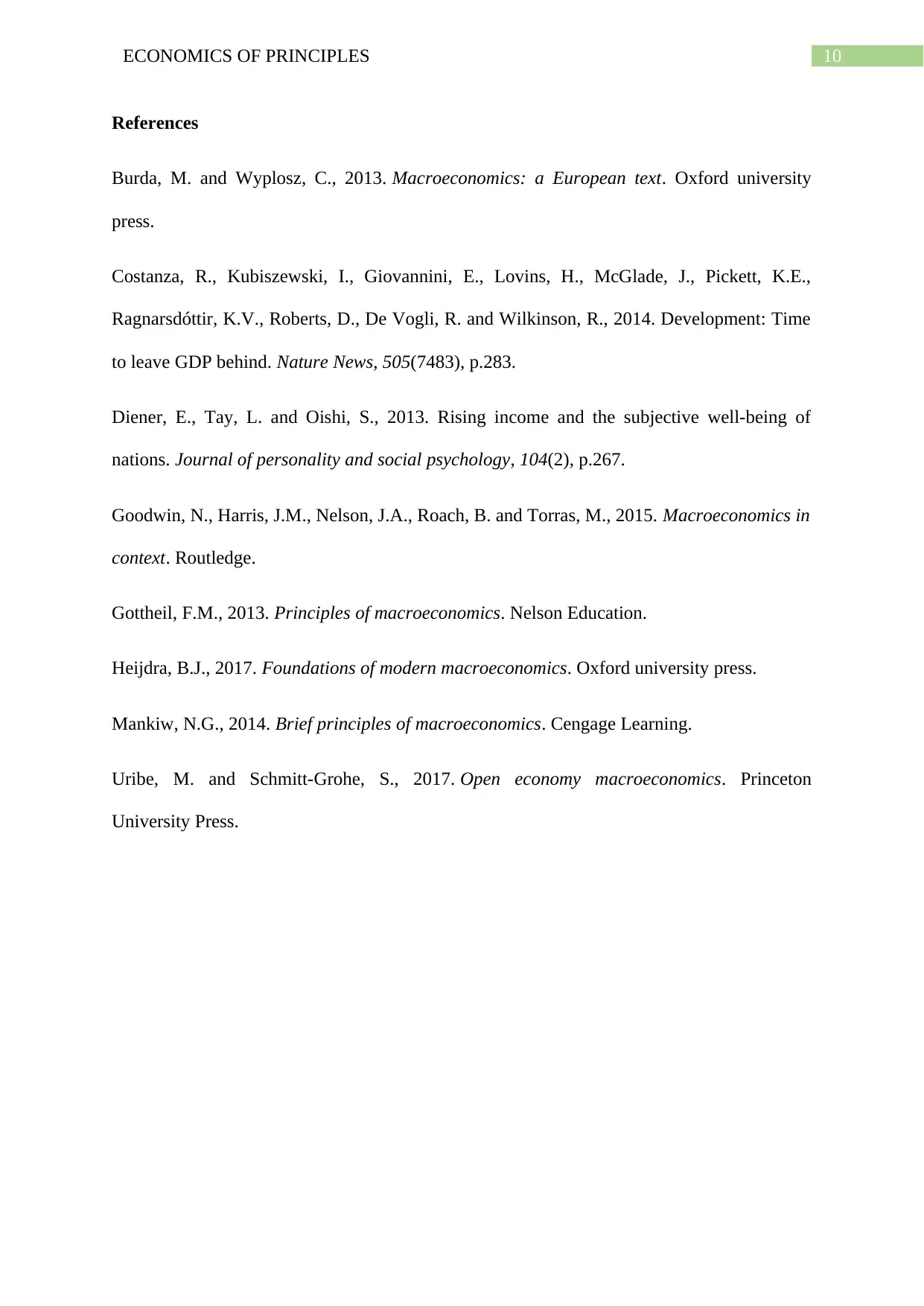
10ECONOMICS OF PRINCIPLES
References
Burda, M. and Wyplosz, C., 2013. Macroeconomics: a European text. Oxford university
press.
Costanza, R., Kubiszewski, I., Giovannini, E., Lovins, H., McGlade, J., Pickett, K.E.,
Ragnarsdóttir, K.V., Roberts, D., De Vogli, R. and Wilkinson, R., 2014. Development: Time
to leave GDP behind. Nature News, 505(7483), p.283.
Diener, E., Tay, L. and Oishi, S., 2013. Rising income and the subjective well-being of
nations. Journal of personality and social psychology, 104(2), p.267.
Goodwin, N., Harris, J.M., Nelson, J.A., Roach, B. and Torras, M., 2015. Macroeconomics in
context. Routledge.
Gottheil, F.M., 2013. Principles of macroeconomics. Nelson Education.
Heijdra, B.J., 2017. Foundations of modern macroeconomics. Oxford university press.
Mankiw, N.G., 2014. Brief principles of macroeconomics. Cengage Learning.
Uribe, M. and Schmitt-Grohe, S., 2017. Open economy macroeconomics. Princeton
University Press.
References
Burda, M. and Wyplosz, C., 2013. Macroeconomics: a European text. Oxford university
press.
Costanza, R., Kubiszewski, I., Giovannini, E., Lovins, H., McGlade, J., Pickett, K.E.,
Ragnarsdóttir, K.V., Roberts, D., De Vogli, R. and Wilkinson, R., 2014. Development: Time
to leave GDP behind. Nature News, 505(7483), p.283.
Diener, E., Tay, L. and Oishi, S., 2013. Rising income and the subjective well-being of
nations. Journal of personality and social psychology, 104(2), p.267.
Goodwin, N., Harris, J.M., Nelson, J.A., Roach, B. and Torras, M., 2015. Macroeconomics in
context. Routledge.
Gottheil, F.M., 2013. Principles of macroeconomics. Nelson Education.
Heijdra, B.J., 2017. Foundations of modern macroeconomics. Oxford university press.
Mankiw, N.G., 2014. Brief principles of macroeconomics. Cengage Learning.
Uribe, M. and Schmitt-Grohe, S., 2017. Open economy macroeconomics. Princeton
University Press.
1 out of 11
Related Documents
Your All-in-One AI-Powered Toolkit for Academic Success.
+13062052269
info@desklib.com
Available 24*7 on WhatsApp / Email
![[object Object]](/_next/static/media/star-bottom.7253800d.svg)
Unlock your academic potential
© 2024 | Zucol Services PVT LTD | All rights reserved.





